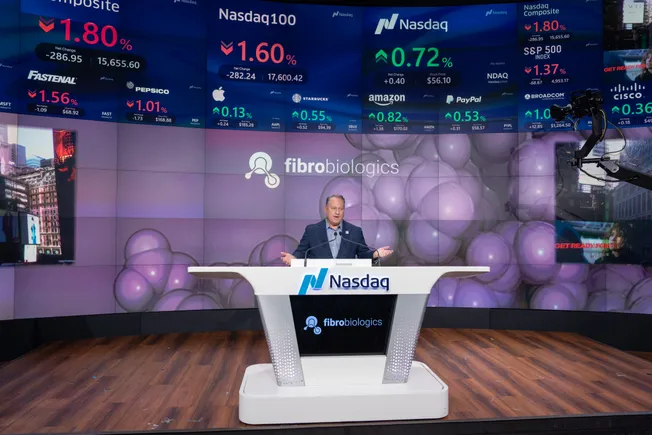This audio is automatically generated. feedback.
Welcome to today’s Biotech Spotlight, a series highlighting companies creating groundbreaking technologies and products. Today we feature FibroBiologics, a biotech company that is blazing an unconventional path by funding its fibroblast-based human trials with a direct IPO.
focus: Pete O’Heeron, CEO of FibroBiologics

Pete O’Heeron, CEO of FibroBiologics
Used with permission from FibroBiologics
FibroBiologics Vision: The company aims to develop and commercialize fibroblast-based therapies for a variety of conditions, including degenerative disc disease, multiple sclerosis, wound healing and cancer. To get to human trials, the biotech company conducted its own initial public offering earlier this year, stepping away from traditional fundraising.
Science: Texas-based FibroBioLogics is working on a fibroblast technology to regenerate tissues and organs and treat diseases in a manner similar to stem cell therapy. Fibroblasts, which make up the main cell type in connective tissue, are more abundant than stem cells and share many of the same properties as stem cells, including the ability to regenerate, according to the company. The company holds more than 150 patents and has five candidates in its pipeline, two in preclinical, two in discovery, and one in Phase 1.
The company’s Phase 1 multiple sclerosis candidate, CYMS101, which is in the early stages of research and development, has entered a small, 16-week clinical trial. MS Clinical Trials For your safety.
FibroBiologics plans to conduct more human trials, but the timeline for these is not being disclosed.
“It’s like[our scientists]are on Mars, and every step they take is the first step no one has taken before, so I can’t say right now,” O’Heeron said of when the company’s next product might make it into the clinic. But the CEO has the advantage of knowing where the money will come from, i.e. what a direct IPO will look like.
IPO Path: Most biotech startups have several funding options, including grants, venture capital, and partnerships with big pharma companies.
FibroBiologics isn’t satisfied with its current fundraising situation, O’Heeron said. Biotech funding optimism It’s on the rise this year, according to GlobalData.
“Once you’ve done all the preclinical work, you have to develop a master cell bank and then do human trials,” he said. “That’s where the real cost comes in. And it’s very hard to raise that money on the private market. That’s why biotech companies go public – they have the access and the liquidity to make bigger investments.”
O’Heeron said FibroBiologics had difficulty raising venture capital because it was funded by family doctors and surgeons and didn’t include well-known companies, and potential investors were more interested in external factors than fundamental science.
“No matter how many times you get told ‘no,’ the science doesn’t change,” O’Heeron says. “You might pitch this project to 200 institutional investors, and all 200 of them might say no, because there’s no big name involved in this project. But that doesn’t change the underlying science.”
For O’Healon, an IPO was always the goal. Fibro Biologics $100 million in 2021 After the company went public, it acquired shares from private investment group GEM Global Yield in a 36-month contract. FibroBiologics also used crowdfunding. Over $1 million raised Within the first 24 hours on the crowdfunding platform Start the engine 2023.
O’Heeron didn’t see the value in a traditional IPO and instead opted for a direct IPO. With funding already raised from surgeons and family doctors and 400 accredited investors, the company initiated the IPO process itself. Having such a large shareholder base was a positive for the company, as it qualified it for a direct listing on the Nasdaq. Conversely, having such a large shareholder base would have been a “weak point” in raising capital from VCs, O’Heeron says.
Why is this important: FibroBioLogics’ IPO is part of a recovery in biotech IPOs after several quiet years. Only 23 biotech IPOs According to McKinsey, the number is expected to peak at 114 in 2021, fall to 100 in 2022 and 30 in 2023. This year, On the rise againBut FibroBiologics’ products still stand out.
First, the company did it on its own, without bank underwriting.
“[We]considered getting the IPO underwritten by a traditional investment bank,” O’Heeron said. “That would have been a tough situation for us because we didn’t want to be 10 months into our IPO and then have an investment bank tell us the night before that we needed to reprice.”
Without institutional investors in FibroBiologics’ investor base, O’Heeron felt the company would not have enough leverage for change and would be in a vulnerable position.
FibroBiologics is unconventional. Direct Listing The company went public on the Nasdaq in January. $10 per share As of the market open on June 4, the company’s market capitalization was $373 million.
O’Heeron said he expects to see increased interest from larger industry players post-IPO.
“Maybe it’s because we’re more well-known, and maybe it’s because we’ve been able to go public and that gives us more credibility,” he said.
O’Heeron has a warning for other biotech companies considering similar moves.
“It’s a lot of work. I was talking to a company yesterday and they asked me how much time I should give to the process. I said, ‘Everything I’ve got,'” he noted. “I spent an hour a day, every day for the better part of seven months, putting it all together. I knew it would be a lot of work, but I didn’t know how long it would take.”
The company remains focused on its science and the development of its fibroblast therapy platform.
“Our future is to have a capital plan that can fund human trials and accelerate the development of what we’re doing,” O’Heeron said. “Our challenge is to have a capital plan that meets the needs of our scientists.”







